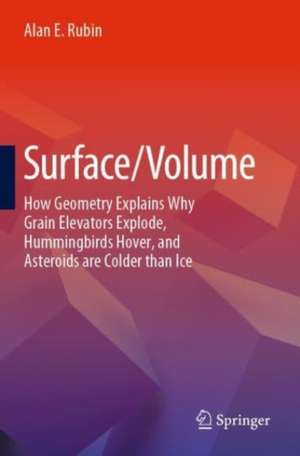Surface/Volume: How Geometry Explains Why Grain Elevators Explode, Hummingbirds Hover, and Asteroids are Colder than Ice
Autor Alan E. Rubinen Limba Engleză Paperback – mar 2023
This book explains that diffusion, osmosis, dissolution, evaporation, and heat loss all preferentially affect small bodies due to their high surface/volume ratios. Because surface area increases as the square of length, but volume (and mass) increase as the cube, large objects have low surface/volume ratios and small objects have high surface/volume ratios. This simple physical constraint governs much of the physical world. It accounts for why the Earth has active volcanoes, but the Moon does not, why the human brain has numerous folds, why deciduous trees lose their leaves every Fall, and why nanoparticles of gold melt at surprisingly low temperatures. It is a phenomenon well known to every scientist, but this book is the first comprehensive treatment of this effect.
Preț: 235.83 lei
Nou
Puncte Express: 354
Preț estimativ în valută:
45.14€ • 49.05$ • 37.94£
45.14€ • 49.05$ • 37.94£
Carte tipărită la comandă
Livrare economică 17-23 aprilie
Preluare comenzi: 021 569.72.76
Specificații
ISBN-13: 9783031237485
ISBN-10: 303123748X
Pagini: 182
Ilustrații: XVII, 182 p. 134 illus., 109 illus. in color.
Dimensiuni: 155 x 235 mm
Greutate: 0.34 kg
Ediția:1st ed. 2023
Editura: Springer Nature Switzerland
Colecția Springer
Locul publicării:Cham, Switzerland
ISBN-10: 303123748X
Pagini: 182
Ilustrații: XVII, 182 p. 134 illus., 109 illus. in color.
Dimensiuni: 155 x 235 mm
Greutate: 0.34 kg
Ediția:1st ed. 2023
Editura: Springer Nature Switzerland
Colecția Springer
Locul publicării:Cham, Switzerland
Cuprins
Introduction.- A Truncated History of Geometry.- Middle School Math.- Asteroids, Moons, Planets, and Meteorites.- Geologic Processes.- Geometry of Life.- Biochemistry.- Chemical Reactions.- Ecology.- Manufacturing.
Notă biografică
Textul de pe ultima copertă
This book explains that diffusion, osmosis, dissolution, evaporation, and heat loss all preferentially affect small bodies due to their high surface/volume ratios. Because surface area increases as the square of length, but volume (and mass) increase as the cube, large objects have low surface/volume ratios and small objects have high surface/volume ratios. This simple physical constraint governs much of the physical world. It accounts for why the Earth has active volcanoes, but the Moon does not, why the human brain has numerous folds, why deciduous trees lose their leaves every Fall, and why nanoparticles of gold melt at surprisingly low temperatures. It is a phenomenon well known to every scientist, but this book is the first comprehensive treatment of this effect.
Caracteristici
Teaches the geometrical approach to nature Explores the physical processes in a variety of objects using surface/volume ratios Explains why the physical properties preferentially affect smaller bodies
